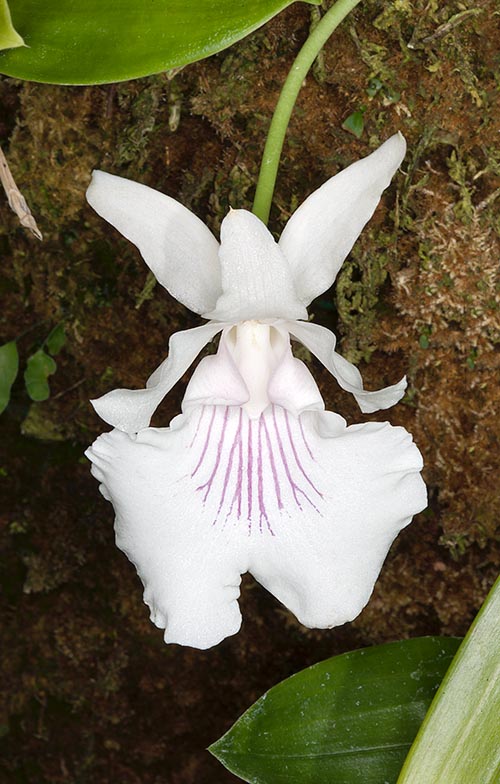Family : Orchidaceae

Text © Pietro Puccio

English translation by Mario Beltramini

Cochleanthes amazonica flower may reach 9 cm and last one month © Giuseppe Mazza
The name of the genus is the combination of the Greek terms “kochlias” = cochlea, spiral and “anthos” = flower; the Latin name of the species, “amazonica” = of Amazonia, refers to its origin place.
Common names: fan-shape orchid (English).
The Cochleanthes amazonica (Rchb.f. & Warsz.) R. E. Schult. & Garay (1959) is an evergreen herbaceous species with a short stem provided of distichous leaves, fanned, linear-lanceolate, 20-25 cm long and 2,5-4 cm broad.
Axillary flowers, solitary, of 7-9 cm of diameter, on a peduncle, hanging or arcuate, 7-10 cm long. The sepals and the petals are similar as shape and size, lanceolate with pointed apex, about 3 cm long and 1,2 cm broad, white and fleshy; the lateral sepals are bent backwards, the petals have slightly wave margins and the apex bent back.
The most conspicuous part of the flower, the labellum, is ample, about 4,5 cm long and 3 cm broad, with rounded apex, slightly bilobate, of white colour with longitudinal purple veins; the column is 2 cm long. It blooms from autumn to spring, the flowers, slightly perfumed, are long-lasting, 3-4 weeks. It reproduces by seed, in vitro, and by division.
Easy to cultivate, warm temperate climate species, floriferous, it requires a shaded position, frequent waterings, in particular when the new leaves are coming out, and high atmospheric humidity, around the 70-80%, with night temperatures not less than 15-16 °C.
As it does not have any storage organs, it should never dry up completely, but without stagnations on the roots and on the axil of the leaves in order to avoid easy rottenness, a good air circulation is important, especially in presence of high temperatures and humidity.
For the waterings and the nebulisations, are to be used either rainwater, water obtained by reverse osmosis or demineralised; the fertilizations, duly distributed in way to avoid accumulations of salts, are to be done preferably with balanced hydrosoluble products, with microelements, at ¼ of the dosage suggested on the package.
It may be mounted on a raft of cork or of arborescent ferns roots, or can grow in pots or baskets with much draining compost, which can be formed by fragments of bark with possible addition of charcoal, sphagnum, agri-perlite, chips of polystyrene foam or coir. It does not love to be disturbed, therefore the repottings are to be done only when strictly necessary and in the moment when the new roots do appear.
The species is entered into the appendix II of the CITES (species whose trade is internationally ruled).
Synonyms: Warczewiczella amazonica Rchb.f. & Warsz. (1854); Warscewiczella amazonica Rchb. f. & Warsz. (1854); Warczewiczella lindenii (Rolfe) auct. (1852); Zygopetalum amazonicum (Rchb.f. & Warsz.) Rchb.f. (1863); Chondrorhyncha amazonica (Rchb.f. & Warsz.) A.D.Hawkes (1965).
→ For general notions about ORCHIDACEAE please click here.
